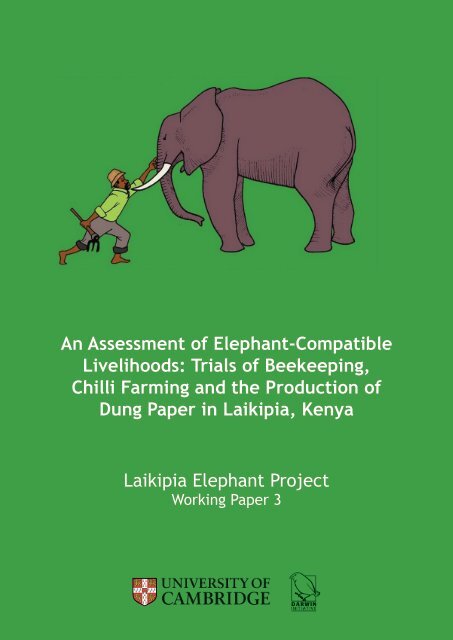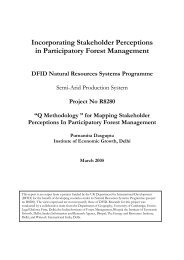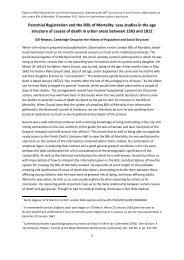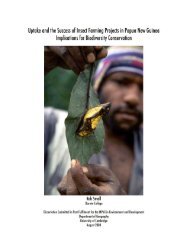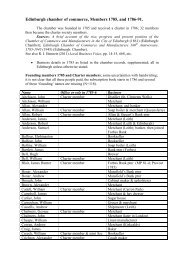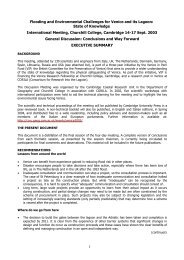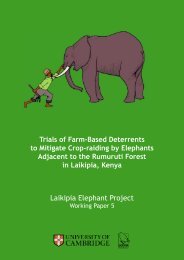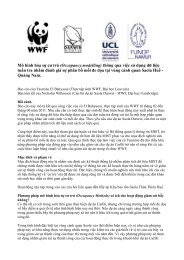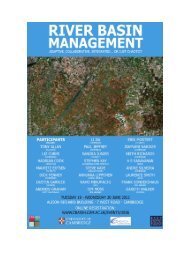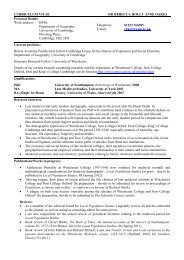An Assessment of Elephant-Compatible Livelihoods - University of ...
An Assessment of Elephant-Compatible Livelihoods - University of ...
An Assessment of Elephant-Compatible Livelihoods - University of ...
Create successful ePaper yourself
Turn your PDF publications into a flip-book with our unique Google optimized e-Paper software.
<strong>An</strong> <strong>Assessment</strong> <strong>of</strong> <strong>Elephant</strong>-<strong>Compatible</strong><br />
<strong>Livelihoods</strong>: Trials <strong>of</strong> Beekeeping,<br />
Chilli Farming and the Production <strong>of</strong><br />
Dung Paper in Laikipia, Kenya<br />
Laikipia <strong>Elephant</strong> Project<br />
Working Paper 3
Laikipia <strong>Elephant</strong> Project<br />
Working Paper 3<br />
<strong>An</strong> <strong>Assessment</strong> <strong>of</strong> <strong>Elephant</strong>-<strong>Compatible</strong> <strong>Livelihoods</strong>:<br />
Trials <strong>of</strong> Beekeeping, Chilli Farming and the Production <strong>of</strong> Dung Paper in Laikipia, Kenya<br />
Max Graham 1,2 , Susie Wren 3 and William M. Adams 2<br />
July 2009<br />
1.Laikipia <strong>Elephant</strong> Project, Private Bag, Cape Chestnut, Nanyuki, Kenya.<br />
2.Department <strong>of</strong> Geography, <strong>University</strong> <strong>of</strong> Cambridge, Cambridge, UK.<br />
3.Laikipia Wildlife Forum, PO Box 764, Nanyuki, Kenya.<br />
Acknowledgements<br />
This study is an output <strong>of</strong> work funded by the UK Government’s<br />
Darwin Initiative for the Survival <strong>of</strong> Species (grant no. 15/040).<br />
The Centre for Training and Research in Arid and Semi-Arid<br />
Lands Development provided institutional support.<br />
The figures were re-drawn by Philip Stickler.<br />
Design and layout were done by James Youlden.<br />
Correct Citation:<br />
Graham, M.D., Wren, S., and Adams, W.M. (2009) <strong>An</strong> <strong>Assessment</strong> <strong>of</strong> <strong>Elephant</strong>-<strong>Compatible</strong><br />
<strong>Livelihoods</strong>: Trials <strong>of</strong> Beekeeping, Chilli Farming and the Production <strong>of</strong> Dung Paper in Laikipia,<br />
Kenya, Working Paper 3, Laikipia <strong>Elephant</strong> Project, Nanyuki, Kenya
Executive Summary<br />
Human-elephant conflict is a significant problem in Kenya. In this paper we share experience<br />
<strong>of</strong> introducing alternative income generating activities for poor rural households to community<br />
based organisations in Laikipia Distict in north-central Kenya in 2007. The activities assessed are<br />
chilli farming, elephant dung paper production and beekeeping. We worked with five community<br />
groups: Mwirere Beekeepers; Riafaji Laikipia Group; Urumwe Beekeepers, Waimungu Self Help<br />
Group; and the Mukogodo Women’s <strong>Elephant</strong> Group. The different activities and projects had<br />
different levels <strong>of</strong> success, but our experience shows that attempts to establish new livelihood<br />
activities in a rural African context is challenging and <strong>of</strong>ten not successful. For the small-scale<br />
farmers living on marginal land that were targeted under this project, honey, chillies and<br />
elephant paper production represent potentially useful complimentary income sources, but<br />
will not be a significant source <strong>of</strong> revenue.<br />
Laikipia <strong>Elephant</strong> Project Working Paper 3 / Page 1
Introduction<br />
Where people and large wild mammals in rural Africa share space they come into conflict over<br />
scarce resources. Such conflict can be severe, resulting in damaged crops and property, human<br />
injury and mortality, and retaliatory killing <strong>of</strong> wild animals (Woodr<strong>of</strong>fe et al. 2005). There are<br />
also a whole range <strong>of</strong> hidden social costs resulting from human-wildlife conflict, such as the<br />
imposition <strong>of</strong> curfews by large dangerous animals and/or exposure to diseases as a result <strong>of</strong><br />
guarding crops/livestock at night, which are more difficult to quantify (Hill 2004; Naughton-<br />
Treves 1997). Increasingly the challenge for conservationists is how to reduce these direct and<br />
indirect costs to tolerable levels among the people who will ultimately decide if wildlife has a<br />
future in rural Africa. Conventional efforts have focussed on minimising the costs <strong>of</strong> humanwildlife<br />
conflict through the creation <strong>of</strong> barriers such as electrified fences (Thouless and Sakwa<br />
1995).<br />
More recently there has been a move to develop simpler and cheaper conflict mitigation tools<br />
such as farm-based deterrents in the case <strong>of</strong> elephants (Osborn and Parker 2003) and predator<br />
pro<strong>of</strong> corrals for the protection <strong>of</strong> livestock at night (Ogada et al. 2003). This body <strong>of</strong> work is<br />
helping human-wildlife conflict practitioners to understand what can minimise costs resulting<br />
from sharing space with wildlife. However one <strong>of</strong> the major constraints with this approach is<br />
that it is based on the premise that rural livelihoods and wildlife are not compatible and therefore<br />
need to be kept separate as best as possible. As a consequence while the development <strong>of</strong><br />
these tools can reduce costs, they do little to make wildlife anymore compatible with current<br />
livelihoods. Furthermore a cost-minimising approach does little to enhance the value <strong>of</strong> wildlife<br />
among the rural people who will ultimately decide if such wildlife has a future at all. As a<br />
consequence, the conservation <strong>of</strong> wildlife remains an enormous challenge in the rural African<br />
context.<br />
The issue <strong>of</strong> the mismatch between those who benefit from wildlife and those who incur costs<br />
inspired a range <strong>of</strong> community-based conservation initiatives across Africa, such as CAMPFIRE in<br />
Zimbabwe (Hulme and Murphee 2001). Most <strong>of</strong> these have been based on benefit sharing through<br />
revenue generated by hunting and game ranching. While these initiatives have not been without<br />
their problems, such programmes have created a value for wildlife which has been difficult to<br />
secure in the absence <strong>of</strong> non-consumptive photographic safaris (Dickson et al. 2009). Where the<br />
latter are not possible or provide an unreliable revenue source across time, such as in the case<br />
<strong>of</strong> Kenya, it might be sensible to support local livelihoods that are more compatible with wildlife<br />
than conventional livelihoods. In the case <strong>of</strong> elephants this concept has led to the trial and promotion<br />
<strong>of</strong> chilli farming as elephants do not eat chillies (Parker and Osborn 2006) and trials and<br />
promotion <strong>of</strong> beekeeping as elephants will avoid being stung by bees (King et al. 2009).<br />
In this paper we assess the potential for elephant-compatible revenue generating activities on<br />
the Laikipia plateau in north-central Kenya. Alternative income generating activities were introduced<br />
to community based organisations in Laikipia in 2007. The activities investigated were<br />
chilli farming, elephant dung paper production and beekeeping.<br />
Study Area<br />
The Laikipia Plateau (9,700 km2) comprising three districts, is located in north-central Kenya<br />
at an elevation <strong>of</strong> 1700-2000m above sea level northwest <strong>of</strong> Mt. Kenya and northeast <strong>of</strong> the<br />
Aberdare highlands. Rainfall in Laikipia falls in two seasons, the ‘long rains’, between April<br />
and June, and the ‘short rains’, between October and December, although rain showers may fall<br />
at any time <strong>of</strong> year. <strong>An</strong>nual rainfall falls along a steep gradient from between 750 mm in the<br />
Laikipia <strong>Elephant</strong> Project Working Paper 3 / Page 2
southern part <strong>of</strong> the plateau near the massifs <strong>of</strong> Mt Kenya and the Aberdares to 300 mm in the<br />
lower, northern part <strong>of</strong> the plateau (Berger 1989; Gichuki et al. 1998).<br />
The variation in altitude and rainfall across the plateau is associated with marked changes in<br />
land use, from protected upland forest, through a belt <strong>of</strong> smallholder cultivation to savannah<br />
under large-scale commercial ranching, to traditional transhumant pastoralism and wildlife conservation.<br />
There is extensive commercial wheat and irrigated flower and vegetable cultivation<br />
in Eastern Laikipia, near the growing urban centre <strong>of</strong> Nanyuki. Unusually for a landscape without<br />
government gazetted wildlife areas, Laikipia hosts the second highest densities <strong>of</strong> wildlife<br />
in Kenya, after the Maasai Mara, including the country’s second largest population <strong>of</strong> elephants<br />
(Georgiadis et al. 2007; Omondi et al. 2002). Tourism based on this wildlife resource plays an<br />
increasing role in the local economy. Today there are wildlife-based tourism enterprises on 18 <strong>of</strong><br />
the 41 large-scale ranches (2000 to 93,000 acres) which cover 42% <strong>of</strong> the district, and five <strong>of</strong> the<br />
nine communally owned group ranches which collectively cover 11% <strong>of</strong> the district (Graham et<br />
al. in press).<br />
<strong>An</strong> aerial survey <strong>of</strong> Laikipia in 2002 recorded 3,036 elephants (Omondi et al. 2002). Some <strong>of</strong><br />
these elephants contribute to high levels <strong>of</strong> human-elephant conflict, particularly crop-raiding,<br />
on smallholder farms in the south <strong>of</strong> the plateau (Thouless 1994; Graham 2007). In 2007, funds<br />
were secured by a local NGO, the Laikipia Wildlife Forum, to construct 163 km <strong>of</strong> fence across<br />
the southern part <strong>of</strong> the plateau to separate smallholder cultivation where elephants are not<br />
tolerated from large-scale ranches where elephants are tolerated.<br />
Methods<br />
Community Groups<br />
In 2007 we identified five<br />
community based organisations<br />
(CBOs) to support in<br />
developing elephant-compatible<br />
livelihoods: Mwirere<br />
Beekeepers; Riafaji Laikipia<br />
Group; Urumwe Beekeepers,<br />
Waimungu Self Help Group;<br />
and the Mukogodo Women’s<br />
<strong>Elephant</strong> Group (Fig 1; Table<br />
1). The former four groups<br />
were chosen on the basis<br />
that they lived in areas with<br />
high incidence <strong>of</strong> humanelephant<br />
conflict and were<br />
easily accessible by road.<br />
The Mukogodo Women’s<br />
<strong>Elephant</strong> Group was more<br />
remote but was identified as<br />
a priority group to work with<br />
by a local partner organisation<br />
(The Symbiosis Trust).<br />
Of the five CBOs all existed<br />
before our project started<br />
with the exception <strong>of</strong> Riafaji<br />
Figure 1: Location <strong>of</strong> Community Groups<br />
(Continued over page)<br />
Laikipia <strong>Elephant</strong> Project Working Paper 3 / Page 3
which was created with support from project staff at the request <strong>of</strong> local farmers. Each <strong>of</strong> these<br />
groups was registered or provided with support to be registered with the Department <strong>of</strong> Social<br />
Security as a community-based organisation and each group had elected a chairman, treasurer<br />
and secretary.<br />
Table 1: Community based organisations<br />
Name No. Members Location Year Established Activities<br />
Mwireri<br />
Beekeeper’s Group<br />
25 Ex-Erok, Laikipia East<br />
District<br />
Urumwe 15 Mutara, Laikipia East<br />
District<br />
Riafaji Laikipia<br />
Group<br />
Waimungu Self<br />
Help Group<br />
Mukogodo Women’s<br />
<strong>Elephant</strong> Group<br />
30 Pesi, Laikipia West<br />
District<br />
15 Salaama, Laikipia West<br />
District<br />
34 Mukogodo Forest,<br />
Laikipia East District<br />
2004 Beekeeping, Tree<br />
planting<br />
2004 Beekeeping, livestock<br />
husbandry<br />
2007 Grow crops that<br />
elephants don’t eat<br />
2001 Buying corrugated iron<br />
sheets for ro<strong>of</strong>ing, tree<br />
planting, beekeeping<br />
and HIV awareness<br />
2005 Production <strong>of</strong> elephant<br />
dung paper<br />
Data Collection<br />
The performance <strong>of</strong> elephant compatible livelihoods was monitored through field observations<br />
following their introduction, and through secondary information made available by project<br />
partners. Perceptions <strong>of</strong> the performance <strong>of</strong> the livelihoods activities were assessed through<br />
semi-structured interviews with members <strong>of</strong> the CBOs involved. For this purpose a simple check<br />
list <strong>of</strong> topics was prepared prior to the interview. Interviews were carried out between February<br />
and March 2009.<br />
<strong>Elephant</strong>-<strong>Compatible</strong> Enterprises<br />
Chilli Farming<br />
Modern food crops have been subjected to successive selective breeding until their natural and<br />
physical defences have been reduced and nutritive value is high and are therefore vulnerable<br />
to depredation by wild animals. As a consequence human-wildlife conflict practitioners have<br />
proposed using less palatable crops, either as a buffer between cultivated farms and wildlife<br />
refuges or as an alternative to conventional crops where human-wildlife conflict is severe<br />
(Parker and Osborn 2003). In one study in Zimbabwe chilli peppers were found to perform<br />
favourably against cotton, maize and sorghum in terms <strong>of</strong> survival from mammalian damage<br />
and economic yield (Parker and Osborn 2003). Furthermore chilli peppers have been used with<br />
some success as a crop-raiding deterrent in both Zimbabwe (Osborn and Parker 2003) and Kenya<br />
(Sitati and Walpole 2006; Graham and Ochieng 2008). This previous body <strong>of</strong> work provided<br />
justification for supporting Riafaji and Waimungu CBOs to propagate chilli pepper on their<br />
members’ farms.<br />
‘Bird’s eye’ chilli pepper seeds were sourced locally and provided to 15 farmers from Waimungu<br />
CBO and 12 farmers from Riafaji. In addition technical support for chilli farming was provided<br />
by an agricultural extension <strong>of</strong>ficer working with a local partner organisation, the Kenya Horticultural<br />
Development Programme (KHDP), in September 2007. A market for harvested chillies<br />
Laikipia <strong>Elephant</strong> Project Working Paper 3 / Page 4
was secured locally, through MAIZE foods, based in Eldoret, prior to engaging farmers in trialling<br />
chilli farming.<br />
Dung Paper<br />
The origins <strong>of</strong> papermaking have been traced to China in about 105 AD and the use <strong>of</strong> paper for<br />
writing became widespread by the third century. Paper was made by hand until the development<br />
<strong>of</strong> the Fourdrinier machine, created in the early 1800s in Europe, which produces a<br />
continuous roll <strong>of</strong> paper rather than individual sheets (Needham 1986; Biermann 1993).<br />
<strong>Elephant</strong> dung paper is produced in a similar way to that <strong>of</strong> normal handmade paper, involving<br />
making a dilute suspension <strong>of</strong> fibres, in this case elephant dung mixed with recycled paper in<br />
water with wood glue. This suspension is then drained through a wire screen in a wooden<br />
frame, called a deckle, so that a mat <strong>of</strong> randomly interwoven fibers is laid down. Water is<br />
removed from this mat <strong>of</strong> fibers by pressing and drying on a stretched sheet (felt or cotton)<br />
to make paper.<br />
Production <strong>of</strong> elephant dung paper today occurs in many elephant range states in both Asia and<br />
Africa, resulting in a range <strong>of</strong> products from simple writing sheets, to diaries and large scrap<br />
books. The curio market in tourist areas across both continents provides an opportunity for<br />
artisans to generate revenue through the presence <strong>of</strong> elephants.<br />
Members <strong>of</strong> the Mukogodo Women’s <strong>Elephant</strong> Group were trained on how to make elephant dung<br />
paper in 2005. Initially members <strong>of</strong> the Mukogodo Women’s <strong>Elephant</strong> Group were trained to<br />
Laikipia <strong>Elephant</strong> Project Working Paper 3 / Page 5
make simple writing paper sets with envelopes. Subsequently they were trained to make much<br />
larger pieces <strong>of</strong> paper to order. The Symbiosis Trust, a partner organisation provided inputs, a<br />
work station, quality control, marketing support and book keeping.<br />
Beekeeping<br />
Results from research carried out in Kenya showed that the presence <strong>of</strong> bees and even<br />
unoccupied beehives in trees provides some degree <strong>of</strong> protection from browsing by elephants,<br />
suggesting that African bees <strong>of</strong>fer potential as an elephant deterrent (Vollrath and Douglas-<br />
Hamilton 2002). However the limited trials carried out to test the deterrent effect <strong>of</strong> bees in<br />
preventing crop-raiding by elephants were inconclusive (Karidozo and Osborn 2007, though see<br />
King et al. 2009). Furthermore there are numerous practical challenges to using African bees as<br />
a crop-raiding deterrent such as the threat they pose to people, their diurnal ecology and the<br />
resources required to create beekeeping capacity among vulnerable farmers. Further experimental<br />
trials are needed to test the performance <strong>of</strong> bees as an elephant deterrent (King et al.<br />
2009). Beekeeping does, however, represent an elephant-compatible livelihood enterprise for<br />
rural Africans sharing space with elephants. It was on this basis that we provided some training<br />
and support to Waimungu, Urumwe and Mwireri self help groups to improve their existing<br />
beekeeping activities. In 2007 Waimungu and Urumwe beekeeping groups were taken for a field<br />
day to the Ngare Ndare Forest in north-east Laikipia where they were provided with training on<br />
beekeeping by the Ngare Ndare Forest Association which operates a highly successful community<br />
beekeeping project. In 2007 Mwireri Beekeepers whose members were suffering extensive crop<br />
depredation by elephants were introduced to Lucy King, a PhD student from Oxford <strong>University</strong>,<br />
who is investigating the deterrent effect <strong>of</strong> bees. The group was provided with eight beehives<br />
(for beehive experiments) bringing the total the group own collectively to 23. The group was<br />
provided with training on beekeeping through a field day provided on site (see King et al. 2009<br />
for more details).<br />
Performance <strong>of</strong> <strong>Elephant</strong>-<strong>Compatible</strong> Enterprises<br />
Chillies<br />
Five <strong>of</strong> the 15 nurseries established by Waimungu farmers were destroyed by frost.<br />
The remaining seedlings took a very long time to germinate resulting in some farmers abandoning<br />
their nurseries altogether. Just three farmers from the original 15 managed to transplant<br />
chilli seedlings into their fields. However most <strong>of</strong> these seedlings didn’t survive the dry conditions<br />
in this rain-fed area and so there were very few plants that reached maturity.<br />
Of the 12 nurseries established by Riafaji farmers, seeds germinate in only seven. Three nurseries<br />
and transplanted seedlings were destroyed by flooding <strong>of</strong> riparian land. The chilli plants that<br />
were successfully transplanted produced very small fruits and took a long time to reach maturity<br />
with the result that just 20kg <strong>of</strong> chillies were eventually harvested.<br />
The problem <strong>of</strong> germination and the slow growth rate <strong>of</strong> the seedlings experienced by farmers<br />
from both community groups suggest that the seed supplied was flawed. Other problems<br />
experienced with propagation <strong>of</strong> the chilli seeds such as frost, flooding and lack <strong>of</strong> water suggest<br />
that the extension services provided were either too little too late or simply did not give the<br />
farmers sufficient knowledge to deal with the challenges <strong>of</strong> growing chillies in their respective<br />
environments. The selection <strong>of</strong> community groups on the basis <strong>of</strong> their vulnerability to humanelephant<br />
conflict, rather than their suitability for chilli farming, may have also compounded the<br />
challenges faced in establishing successful chilli plants on farms.<br />
Laikipia <strong>Elephant</strong> Project Working Paper 3 / Page 6
Beekeeping<br />
Within a few months <strong>of</strong> the provision <strong>of</strong> training by the Ngare Ndare Forest Association, six <strong>of</strong><br />
ten hives at Waimungu were colonised where as previously this group had no hives colonised.<br />
Similarly, after the field day to Ngare Ndare Forest, Urumwe beekeepers successfully succeeded<br />
in colonising 10 out <strong>of</strong> 19 hives as compared to just two previously. However by March 2009 the<br />
number <strong>of</strong> hives colonised had reduced to just three among Waimungu members and six among<br />
Urumwe members. Waimungu beekeepers reported that they have never actually successfully<br />
harvested honey from their hives, despite the provision <strong>of</strong> training on how to do so. Urumwe<br />
members now harvest on average about 20kg a year, and the honey is sold locally for Ksh 300<br />
($ US 3.8) per kg.<br />
In March 2009, Mwireri beekeepers reported that just one <strong>of</strong> their 23 beehives was colonised,<br />
with many <strong>of</strong> the previously colonised hives having been abandoned by as a result <strong>of</strong> persistent<br />
drought. When conditions are more favourable the group reported that they harvest honey from<br />
their hives approximately once every two years with most <strong>of</strong> the honey consumed locally or sold<br />
for approximately Ksh 200 per kg.<br />
Dung Paper<br />
The Mukogodo Womens’s <strong>Elephant</strong> Group entered into a partnership with the Symbiosis Trust,<br />
creating elephant dung paper products on demand. In total ksh 70,000 (approximately $ US<br />
1,000) was generated for the women’s group over an 18 month period. However the cost <strong>of</strong><br />
production was subsidised by the provision <strong>of</strong> pro-bono extension services and outreach support<br />
by The Symbiosis Trust. The Trust collected waste paper and other dung paper inputs (such as<br />
wood glue, wooden frames, nets, etc), delivered this to the production site in the Mukogodo<br />
Forest, collected and packaged finished products and delivered these to the market. In addition<br />
the Symbiosis Trust helped support the group with book keeping and resolving internal disputes.<br />
Insufficient revenue was generated to cover the cost <strong>of</strong> this support, suggesting that the enterprise<br />
was not financially viable at the levels <strong>of</strong> production achieved. As a consequence in 2008<br />
The Symbiosis Trust withdrew extension support from the project as it could no longer afford<br />
to provide free labour and transport to subsidise the production and sale <strong>of</strong> dung paper. The<br />
Mukogodo Women’s <strong>Elephant</strong> Group have not produced or sold any more dung paper since the<br />
trust withdrew its outreach support.<br />
Barriers to the Uptake and Performance<br />
<strong>of</strong> <strong>Elephant</strong> <strong>Compatible</strong> Livelihood Options<br />
The performance <strong>of</strong> the livelihood enterprises supported during the project period was mixed<br />
but clearly a great deal more support would be required if these enterprises were to be successfully<br />
taken up by these and other community groups in Laikipia. This support would need<br />
to overcome a number <strong>of</strong> barriers identified during the follow up field assessment. These are<br />
summarised here.<br />
Environmental<br />
Lack <strong>of</strong> rainfall was cited as a problem by both Mwireri Beekeepers Group and Waimungu. In<br />
the case <strong>of</strong> the former this resulted in the absence <strong>of</strong> water and forage for bees, leading to the<br />
group’s hives being abandoned and harvests taking place just once every two years. Furthermore<br />
any potential for engaging this group with any other appropriate livelihood activity such<br />
as trialling dry land crops will be constrained by the absence <strong>of</strong> water as the aquifer occurs at a<br />
Laikipia <strong>Elephant</strong> Project Working Paper 3 / Page 7
depth <strong>of</strong> 300m or more. People from Waimungu complained that lack <strong>of</strong> rainfall has led to the<br />
failure <strong>of</strong> their chilli crops. However as this group lives in the vicinity <strong>of</strong> the Rumuruti Forest<br />
and associated permanent water bees are not affected by dry spells in the same way as at<br />
Ex-Erok where Mwireri Beekeepers live.<br />
People from Riafaji have access to permanent water from the Pesi River and use this to irrigate<br />
their crops. They are therefore well positioned to propagate chilli plants. However Laikipia has<br />
suffered from recurrent drought in recent years and the issue <strong>of</strong> water abstraction from rivers<br />
for agricultural use is leading to reduced dry season flow and problems for downstream users.<br />
As a consequence any future work undertaken with Riafaji should ensure the group has secured<br />
appropriate water permits from the local water management authority, use irrigation methods<br />
that optimise water use and minimise wastage and create dry season water storage.<br />
Organisational<br />
Problems <strong>of</strong> internal rivalry and pressure from external groups lead to leadership conflicts within<br />
the Waimungu Self Help and Mukogodo Women’s <strong>Elephant</strong> Group. In both cases this had led to<br />
the break up <strong>of</strong> the groups in the recent past. In the case <strong>of</strong> the Waimungu group perceptions<br />
over lack <strong>of</strong> benefits generated through membership had led to some members defaulting on<br />
regular ‘merry-go-round’ contributions. While income generating activities were relatively<br />
limited among all the groups surveyed, it was clear that, beyond cursory governance structures,<br />
there is a lack <strong>of</strong> capacity in bookkeeping, recording systems, governance and transparent<br />
financial handling. Capacity needs to be developed in all <strong>of</strong> these areas to build confidence<br />
among group members.<br />
With the exception <strong>of</strong> the Mukogodo Women’s <strong>Elephant</strong> Group, women were under represented<br />
in the livelihood groups surveyed possibly reflecting social conditions that limit opportunities for<br />
women to be involved in commercial enterprises.<br />
Commercial<br />
Achieving adequate product volume and product quality is the biggest barrier to securing<br />
markets for the elephant-compatible products trialled among the livelihood groups surveyed<br />
with the exception <strong>of</strong> Riafaji group which is well positioned to produce chillies on a commercial<br />
basis. While for some groups this barrier might be overcome with adequate training and outreach<br />
support, such as with beekeeping and chilli farming, there are other constraints that are<br />
leading to barriers to production <strong>of</strong> adequate volume and quality for market entry. For example<br />
environmental conditions are unsuitable for consistent production <strong>of</strong> honey among the Urumwe<br />
beekeepers group. Furthermore limited access to land and labour makes the opportunity cost <strong>of</strong><br />
trialling new crops very high among all livelihood groups, limiting opportunities for initial uptake<br />
and reducing quantities produced. Lastly opportunities to improve cooperation among different<br />
groups for the purpose <strong>of</strong> increasing bulk and achieving economies <strong>of</strong> scale are limited by lack <strong>of</strong><br />
resources for transport, coordination and communication.<br />
Without access to financial support and training on business skills the livelihood groups surveyed<br />
have little opportunity to add value to raw products, limiting supply to local rather than<br />
regional, national and international markets.<br />
Laikipia <strong>Elephant</strong> Project Working Paper 3 / Page 8
Discussion<br />
Beekeeping<br />
Significant investments would be required to develop the capacity <strong>of</strong> the dryland smallholder<br />
groups surveyed (Waimungu and Riafaji) to generate honey for the market and associated<br />
revenue in any significant quantity. This is clearly expensive and difficult to achieve which has<br />
been a major barrier to attempts at successful honey production among the smallholder groups<br />
surveyed. It is important to note that during the course <strong>of</strong> our interviews we were informed that<br />
there were many other groups in southern Laikipia comprised <strong>of</strong> immigrant small-scale farmers<br />
who had also tried and failed to produce honey on any commercially viable scale. In each case<br />
it appears initial investment and support was provided by an outside organisation only for this<br />
organisation to stop providing support with the beekeeping enterprise eventually confined to<br />
a few households or collapsing altogether. Given this history <strong>of</strong> failure to achieve commercial<br />
honey production among smallholder groups in southern Laikipia it may be more feasible to support<br />
the resident traditional beekeeping groups who already produce honey in large quantities<br />
but operate outside <strong>of</strong> the formal commercial market.<br />
There is a strong tradition <strong>of</strong> beekeeping among the Mukogodo Maasai living within and around<br />
the Mukogodo Forest in north Laikipia. This is illustrated by the large and active membership<br />
<strong>of</strong> the Lotoro Sieku Group (200+ members) who were opportunistically interviewed during the<br />
course <strong>of</strong> the fieldwork undertaken in March 2009 for this working paper. We therefore strongly<br />
recommend that any future investment in honey production should begin here, where sustainability<br />
might be more easily achieved, before taking on the more difficult challenge <strong>of</strong> establishing<br />
commercial honey production among smallholders in southern Laikipia.<br />
Chilli Production<br />
Of the community groups surveyed the Riafaji Group is ideally placed for growing chillies due<br />
to members’ access to perennial water (the Pesi River) and their high levels <strong>of</strong> organisation.<br />
Members <strong>of</strong> this group are already engaged in intense horticulture for good returns as they have<br />
set themselves up as out growers for a commercial partner, Homegrown Ltd. The group’s interest<br />
in growing alternative crops such as chillies is therefore to create a hedge against the risks<br />
associated with human-elephant conflict. It is unfortunate that the initial trials were hampered<br />
by the provision <strong>of</strong> poor quality seed and inadequate outreach support. If these two issues can<br />
be addressed, then this group will be well placed to produce chillies on a commercial scale.<br />
<strong>Elephant</strong> Dung Paper Production<br />
The Mukogodo Women’s <strong>Elephant</strong> Group achieved a great deal with very little financing, largely<br />
due to the enthusiasm <strong>of</strong> the project instigator and the local women involved. However the<br />
dung paper making enterprise remains operational at a very small scale. This is largely due<br />
to a lack <strong>of</strong> financial capacity to invest in equipment, training, marketing and management<br />
assistance. Given that the volumes produced were very low and the investment required in<br />
quality control and product development is high, it would be more cost-effective and practical<br />
to encourage a commercial partner to produce elephant dung paper in Nanyuki town to reduce<br />
travel costs. If and when a larger market is secured for the dung paper products generated and<br />
sufficient revenue flows are achieved then it might be possible to extend production to groups<br />
further afield. However transport costs to these sites are likely to continue to be a barrier to<br />
pr<strong>of</strong>itable production unless carried on the back <strong>of</strong> other enterprise activities occurring in such<br />
remote sites (e.g. honey production).<br />
Given that honey production in and around the Mukogodo Forest already occurs at a large scale,<br />
albeit not for commercial purposes, it would be worth providing support and training so that<br />
Laikipia <strong>Elephant</strong> Project Working Paper 3 / Page 9
members <strong>of</strong> the Mukogodo <strong>Elephant</strong> Women’s Group can be involved in value added activities for<br />
local honey producers.<br />
For the small-scale farmers living on marginal land that were targeted and interviewed under<br />
this project, in particular Mwirere beekeepers, beekeeping represents at best a useful complimentary<br />
income source but will never be a significant source <strong>of</strong> revenue given the shortage<br />
<strong>of</strong> water and associated shortage <strong>of</strong> forage for bees. Given that these groups appear to be<br />
moving to livestock production as a major source <strong>of</strong> household income, it might be better to<br />
help support and develop this enterprise. Trialling the cultivation <strong>of</strong> non-palatable dry land<br />
crops may also be worth pursuing but only if sufficient resources can be made available to cover<br />
opportunity costs among farmers involved in trials, extension services, upscaling production,<br />
quality control and marketing.<br />
Bioenterprises on Laikipia<br />
In 2009, a multimillion dollar ($US) bioenterprise project was developed by the Laikipia Wildlife<br />
Forum with support from USAID, the African Wildlife Foundation and the Royal Netherlands<br />
Embassy with implementation to begin in late 2009. With the intention <strong>of</strong> supporting local livelihoods<br />
through conservation-compatible enterprises this LWF driven bioenterprise project intends<br />
to trial, develop and market natural products in Laikipia in partnership with local community<br />
groups on a large scale. This new LWF initiative will effectively take on or adapt the activities<br />
described in this working paper where appropriate and feasible. However our results and discussions<br />
with community groups demonstrate that attempts to establish new livelihood activities<br />
in a rural African context is challenging and <strong>of</strong>ten not successful. We hope that the results and<br />
experiences described here will inform the design and planning <strong>of</strong> the LWF driven initiative.<br />
Laikipia <strong>Elephant</strong> Project Working Paper 3 / Page 10
References<br />
Dickson, B., Hutton, J. and Adams, W.M. (2009. (Eds.) Recreational Hunting, Conservation and<br />
Rural <strong>Livelihoods</strong>: Science and Practice. London, UK: Wiley-Blackwell.<br />
Berger, P. (1989). Rainfall and Agro-Climatology <strong>of</strong> the Laikipia Plateau, Kenya. Berne: Geo<br />
graphica Bernesia, African Study Series A7.<br />
Biermann, C. J. (1993). Handbook <strong>of</strong> Pulping and Papermaking. San Diego:<br />
Academic Press.<br />
Graham, M.D. (2007). Coexistence in a land use mosaic? Land use, risk and elephant ecology in<br />
Laikipia District, Kenya. PhD thesis, <strong>University</strong> <strong>of</strong> Cambridge, Cambridge, UK.<br />
Graham, M.D. and Ochieng, T. (2008). Uptake and performance <strong>of</strong> farm-based measures for<br />
reducing crop-raiding by elephants Loxodanta africana among smallholder farms in<br />
Laikipia District, Kenya. Oryx 42: 76-82.<br />
Graham, M.D, Douglas-Hamilton, I., Adams, W.M and Lee, P.C. (2009).The movement <strong>of</strong> African<br />
elephants in human-dominated land-use mosaic. <strong>An</strong>imal Conservation (forthcoming).<br />
Hill, C.M. (2004). Farmers’ perspectives <strong>of</strong> conflict at the wildlife-agriculture boundary:<br />
Some lessons learned from African subsistence farmers. Human Dimensions <strong>of</strong><br />
Wildlife 9: 279-286.<br />
Hulme, D. and Murphee, M. (2001). (Eds). African Wildlife and <strong>Livelihoods</strong>. The Promise<br />
and Performance <strong>of</strong> Community Conservation. Oxford, UK: Currey.<br />
Karidozo, M. and Osborn, F. (2007) ‘Human-elephant conflict trials in Zimbabwe: Can bees<br />
deter elephants from raiding crops?’, In Mitigating Human-<strong>Elephant</strong> Conflict: Case Studies<br />
from Africa and Asia, Eds. M. Walpole and M. Linkie. Cambridge, U.K.: Fauna and Flora<br />
International, pp. 29-36.<br />
King, L., Lawrence, A., Douglas-Hamilton, I. and Vollrath, F. (2009). Beehive fence deters<br />
crop-raiding elephants. African Journal <strong>of</strong> Ecology 47: 131-137.<br />
Naughton-Treves, L. (1997). Farming the Forest Edge: Vulnerable Places and People<br />
around Kibale National Park, Uganda. The Geographical Review 87(1): 27-46.<br />
Needham, J. (1986). Science and Civilization in China: Volume 5, Part 1. Taipei: Caves<br />
Books Ltd.<br />
Ogada, M., Woodr<strong>of</strong>fe, R. Oguge, N and Frank, L. (2003). Limiting Depredation by African<br />
Carnivores: the Role <strong>of</strong> Livestock Husbandry. Conservation Biology 17: 1521- 1530.<br />
Osborn, F.V. and Parker, G. (2003). Towards an Integrated approach for reducing the conflict<br />
between elephants and people: a review <strong>of</strong> current research. Oryx 37: 80-84.<br />
Parker, G. and Osborn, F. (2006). Investigating the potential for chilli Capsicum spp. to<br />
reduce human-wildlife conflict in Zimbabwe. Oryx 40 (3): 343-346<br />
Sitati, N.W. and Walpole, M.J. (2006). Assessing farm-based measures for mitigating humanelephant<br />
conflict in Transmara District, Kenya. Oryx 40: 279-286<br />
Thouless, C. and Sakwa, J. (1995). Shocking elephants: fences and crop raiders in<br />
Laikipia District, Kenya. Biological Conservation 72: 99-107.<br />
Vollrath, F. and Douglas-Hamilton, I. (2002). African bees to control African elephants.<br />
Naturwissenchaften 89: 508-11<br />
Woodr<strong>of</strong>fe, R., S. Thirgood, S. and Rabinowitz, A. (2005). (Eds.) People and Wildlife:<br />
Conflict or Coexistence? Cambridge, UK: Cambridge <strong>University</strong> Press<br />
Laikipia <strong>Elephant</strong> Project Working Paper 3 / Page 11
Laikipia <strong>Elephant</strong> Project Working Paper 3 / Page 12
Laikipia <strong>Elephant</strong> Project<br />
Working Papers<br />
1.The Use <strong>of</strong> Electrified Fences to Reduce Human <strong>Elephant</strong> Conflict:<br />
A Case Study <strong>of</strong> the Ol Pejeta Conservancy, Laikipia District, Kenya (2009),<br />
Max Graham, Nathan Gichohi, Francis Kamau, George Aike, Batian Craig,<br />
Iain Douglas-Hamilton, and William M. Adams.<br />
2.The Use <strong>of</strong> ‘Push to Talk’ Mobile Phone Technology to Reduce Human <strong>Elephant</strong> Conflict,<br />
Laikipia District, Kenya (2009)<br />
Max Graham, Christine Greenwood, Gabriel Kahiro, William M. Adams.<br />
3.<strong>An</strong> <strong>Assessment</strong> <strong>of</strong> <strong>Elephant</strong>-<strong>Compatible</strong> <strong>Livelihoods</strong>: Trials <strong>of</strong> Beekeeping, Chilli Farming<br />
and the Production <strong>of</strong> Dung Paper in Laikipia, Kenya (2009)<br />
Max Graham, Susie Wren and William M. Adams<br />
Laikipia <strong>Elephant</strong> Project Working Paper 3 / Page 13
Building Capacity to Alleviate Human-<strong>Elephant</strong><br />
Conflict in North Kenya<br />
DEFRA Darwin Initiative Grant 741<br />
This project aims to enhance the conservation and management <strong>of</strong> Kenya’s<br />
second largest elephant population (over 5,000 animals) and the ecosystem<br />
they inhabit through the implementation <strong>of</strong> an integrated and sustainable community<br />
based approach for alleviating human-elephant conflict (HEC).<br />
The purpose <strong>of</strong> this project is to alleviate human-elephant conflict and promote<br />
tolerance <strong>of</strong> elephants in Laikipia District, Kenya.<br />
The project works to support local partners in the following activities:<br />
• Research on the development <strong>of</strong> systems to provide early warning <strong>of</strong><br />
human-elephant conflict using local knowledge, Mobile phone (‘pushto-talk’)<br />
technologies and GPS/GSM collars;<br />
• Dissemination <strong>of</strong> information on elephant conservation and humanelephant<br />
conflict management in vulnerable communities and local<br />
conservation organisations and land managers;<br />
• Assess the feasibility <strong>of</strong> establishing economic activities that promote<br />
sustainable livelihoods and reduce negative human-elephant conflict;<br />
• Promote the establishment <strong>of</strong> strategy and revenue streams to support<br />
for long term human-elephant conflict management in Laikipia;<br />
• Support local organisations in the development <strong>of</strong> the institutional<br />
capacity to manage the West Laikipia <strong>Elephant</strong> Fence.<br />
The project’s partners are:<br />
CETRAD<br />
<strong>Elephant</strong> Pepper Development Trust<br />
Kenya Wildlife Service<br />
Mpala Research Centre<br />
Ol Pejeta Conservancy<br />
Rivercross Technologies<br />
Save the <strong>Elephant</strong>s<br />
Symbiosis Trust<br />
The Laikipia Wildlife Forum<br />
www.laikipiaelephantproject.org<br />
www.geog.cam.ac.uk/research/projects/heccapacity/<br />
L a i k i p i a W i l d l i f e F o r u m


